Council Tax Reduction in Scotland 2019-2020
Council Tax Reduction (CTR) awarded by age, household structure, income sources and employment status, the deprivation index, and Council Tax band in the financial year from April 2019 till March 2020.
2. Number of CTR recipients
CTR data is reported quarterly and this section provides data for the latest quarter. The number of recipients for each local authority in January, February and March 2020 is shown in Table 2. The total number of recipients in Scotland increased from 466,740 in January 2020 to 469,370 recipients in March 2020, a marginal increase of 0.6 per cent over this quarter. This rise is in line with previous seasonal trends. Most local authorities recorded an increase in CTR recipients (25 out of 32 local authorities), with the largest percentage increase seen in the Scottish Borders (2.7 per cent) over this period. Details of recipients and income forgone since the inception of CTR are available in the Recipients and Income Forgone tables also published at the same time.
| Jan-20 | Feb-20 | Mar-20 | % Change (Jan-Mar 20) |
|
|---|---|---|---|---|
| Scotland | 466,740 | 467,730 | 469,370 | 0.6% |
| Aberdeen City | 13,590 | 13,630 | 13,720 | 1.0% |
| Aberdeenshire | 11,720 | 11,840 | 12,020 | 2.6% |
| Angus | 8,380 | 8,460 | 8,530 | 1.7% |
| Argyll and Bute | 6,500 | 6,510 | 6,580 | 1.3% |
| City of Edinburgh | 32,340 | 32,840 | 32,740 | 1.2% |
| Clackmannanshire | 4,960 | 4,970 | 5,020 | 1.3% |
| Dumfries and Galloway | 13,160 | 13,240 | 13,280 | 0.9% |
| Dundee City | 17,320 | 17,220 | 17,340 | 0.1% |
| East Ayrshire | 12,910 | 12,920 | 12,920 | 0.0% |
| East Dunbartonshire | 5,380 | 5,370 | 5,490 | 2.1% |
| East Lothian | 6,690 | 6,710 | 6,710 | 0.2% |
| East Renfrewshire | 4,210 | 4,200 | 4,240 | 0.7% |
| Falkirk | 12,520 | 12,530 | 12,550 | 0.3% |
| Fife | 29,450 | 29,430 | 29,570 | 0.4% |
| Glasgow City | 87,380 | 87,540 | 87,580 | 0.2% |
| Highland | 16,560 | 16,620 | 16,690 | 0.8% |
| Inverclyde | 9,700 | 9,600 | 9,620 | -0.9% |
| Midlothian | 6,020 | 6,010 | 5,990 | -0.4% |
| Moray | 5,390 | 5,430 | 5,460 | 1.2% |
| Na h-Eileanan Siar | 2,110 | 2,090 | 2,100 | -0.4% |
| North Ayrshire | 16,670 | 16,600 | 16,820 | 0.9% |
| North Lanarkshire | 35,810 | 35,560 | 35,730 | -0.2% |
| Orkney Islands | 1,230 | 1,220 | 1,270 | 2.6% |
| Perth and Kinross | 8,060 | 8,130 | 8,090 | 0.4% |
| Renfrewshire | 17,880 | 17,790 | 17,830 | -0.3% |
| Scottish Borders | 8,150 | 8,420 | 8,370 | 2.7% |
| Shetland Islands | 1,060 | 1,100 | 1,070 | 1.4% |
| South Ayrshire | 10,440 | 10,460 | 10,390 | -0.4% |
| South Lanarkshire | 29,790 | 29,860 | 30,130 | 1.2% |
| Stirling | 5,420 | 5,420 | 5,420 | -0.1% |
| West Dunbartonshire | 11,310 | 11,300 | 11,370 | 0.5% |
| West Lothian | 14,630 | 14,700 | 14,760 | 0.8% |
1 Recipients are as at monthly count date. See Methodology Notes, Section 2 for more details. Available at https://www.gov.scot/publications/council-tax-reduction/
2 Figures are rounded to the nearest 10. Components may not sum to total due to rounding. Percentage change are based on unrounded figures.
Chart 2 shows the number of CTR recipients by local authority as a proportion of the Scottish CTR population for March 2020 in descending order. It can be seen that Glasgow City accounted for the highest proportion, almost one-fifth of all recipients in Scotland which is more than twice the number of recipients in North Lanarkshire (the next highest ranking authority).
The five local authorities with the highest numbers of CTR recipients accounted for almost half (46 per cent) of the total number of CTR recipients for Scotland in March 2020. This can be attributed to the size of the local authorities where those with larger populations may be expected to have a higher number of CTR claimants and therefore recipients. These five local authorities are:
- Glasgow City accounting for 19 per cent (87,580 recipients);
- North Lanarkshire accounting for 8 per cent (35,730 recipients);
- City of Edinburgh accounting for 7 per cent (32,740 recipients);
- South Lanarkshire accounting for 6 per cent (30,130 recipients); and
- Fife accounting for 6 per cent (29,570 recipients).
In contrast, the three island authorities accounted for just 1 per cent when combined together, with only 0.4 per cent in Na h-Eileanan Siar (2,100 recipients), 0.3 per cent in Orkney Islands (1,270 recipients) and with the Shetland Islands accounting for 0.2 per cent, the least (1,070 recipients).
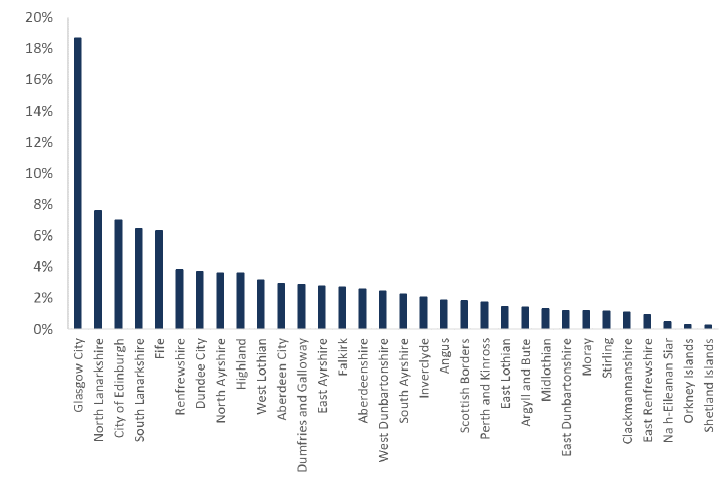
2.1 CTR recipients over time
The number of households receiving CTR in Scotland has gradually decreased from 552,380 in April 2013 to 469,370 in March 2020, a reduction of 15 per cent (83,010 recipients) since the beginning of the scheme. Chart 1 (on page 1) shows the downward trend in the number of recipients over this period.
All local authorities in Scotland have seen a decrease in the number of CTR recipients since the scheme was introduced in April 2013. Chart 3 shows the percentage change between April 2013 and March 2020 for all local authorities in Scotland.
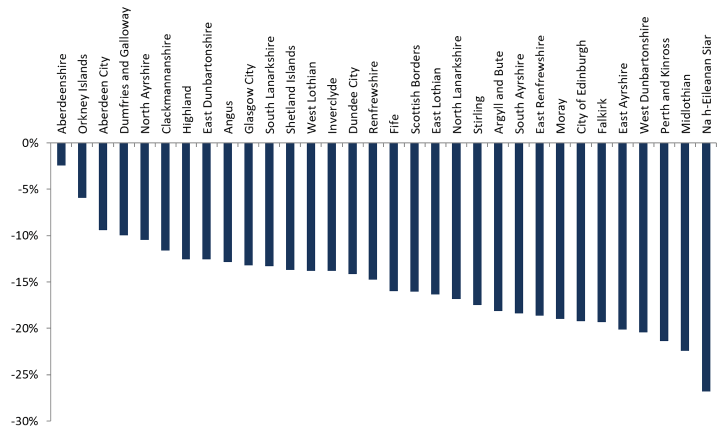
The largest percentage decreases in number of CTR recipients were in Na h-Eileanan Siar (-26.8 per cent), Midlothian (-22.4 per cent) followed by Perth and Kinross (-21.4 per cent). Whilst Na h-Eileanan Siar has a large percentage decrease, this represents a relatively small number of CTR recipients. The smallest percentage decreases were seen in Aberdeenshire (-2.4 per cent), Orkney Islands (-5.9 per cent) and Aberdeen City (-9.4 per cent).
The number of CTR recipients for each local authority for each month between April 2019 and March 2020 are provided in the supplementary tables.
2.2 CTR recipients by passported status
In March 2020, passported recipients accounted for 52 per cent of all CTR recipients. This is down from 58 per cent in March 2019 and 63 per cent in March 2018. UC does not passport people to 100 per cent CTR so as the number of people on UC rises, the number of non-passported cases is expected to increase. As can be seen from chart 4, the most common passporting benefits are Employment and Support Allowance (Income related) and Pension Credit (Guarantee Credit) which made up 45 per cent of all CTR recipients. The majority (83 per cent) of non-passported recipients in March 2020 were not in employment, up from 77 per cent in March 2019.
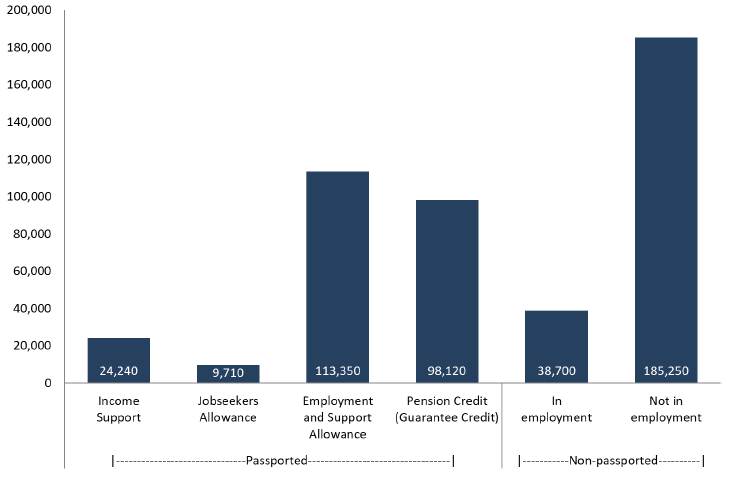
The number of recipients by passported status and local authority in March 2020 is available in the supplementary tables. Some key variations across local authorities are:
- Na h-Eileanan Siar and Glasgow City had the highest proportion of passported CTR recipients (61 per cent and 60 per cent respectively).
- East Lothian had the lowest proportion of passported CTR recipients at 41 per cent. East Lothian was also the first local authority in Scotland to have UC rolled out. A similar proportion of 45 per cent applies in Aberdeenshire, Clackmannanshire, Highland and Inverclyde – with the latter two also subject to an early roll out of UC.
- The number of recipients by passported status from April 2019 to March 2020 is available in the supplementary tables. The figures show that the number of passported CTR recipients has decreased gradually whereas the number of non-passported recipients has increased steadily as expected.
2.3 CTR recipients by age and family type
Chart 5 shows the number of CTR recipients by age group in March 2020. The age group with the highest proportion of CTR recipients was 65 or over, at 37 per cent (171,720 recipients). The age group with the lowest proportion were those under 25 at just over three per cent (15,120 recipients). This can be explained by the fact there are generally less individuals under 25 years old with Council Tax liability and therefore applying for CTR.
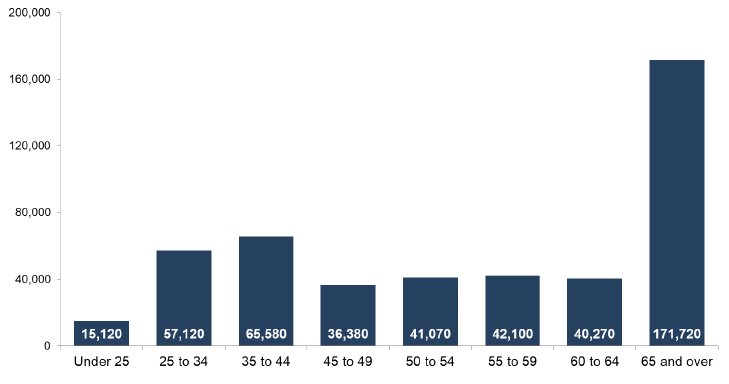
Chart 6 shows the number of CTR recipients by family type in March 2020. Over two thirds of CTR recipients (67 per cent) were single with no child dependent. Lone parents made up 16 per cent, and 17 per cent were couples (with or without children).
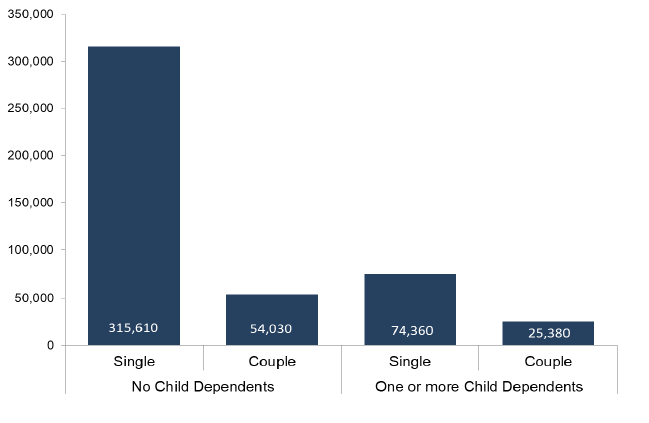
2.4 CTR recipients by deprivation
The Scottish Index of Multiple Deprivation (SIMD) is the Scottish Government's official tool for identifying areas of multiple deprivation. It divides Scotland into 6,976 datazones, each containing around 350 households or approximately 700-800 people. Each datazone has a calculated 'deprivation score' and these scores are then used to rank the datazones. Decile 1 contains the ten per cent most deprived datazones, Decile 2 contains the next ten per cent most deprived, and so on.
It should be noted that the overall SIMD score is a relative measure and assesses deprivation across seven domains – income, employment, education, health, access to services, crime and housing. The CTR scheme is principally concerned with income and household circumstances as a basis for making awards (see Figure 2).
Chart 7 shows the spread of CTR recipients across areas of deprivation using SIMD deciles as described. Similar to March 2019, it can be observed that CTR recipients are heavily concentrated in areas of highest deprivation, with 58 per cent of recipients (272,490) in the lowest three deciles in March 2020.
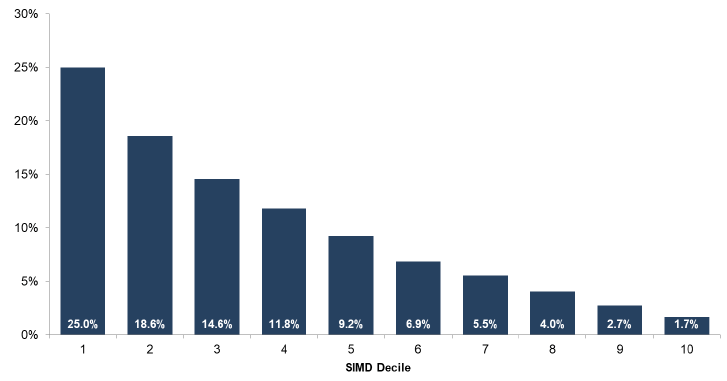
1 This chart is generated by matching postcodes to datazones. Approx. 730 postcode records in the CTR extracts for March 2020 cannot be matched with those in the SIMD2020, have incorrect or missing postcodes in the data.
2 Further details of SIMD2020 are available at https://www.gov.scot/news/scottish-index-of-multiple-deprivation-2020/
2.5 Full and partial CTR
Full CTR refers to recipients whose Council Tax liability is reduced to zero. Partial CTR refers to recipients whose Council Tax liability is reduced, but they are still liable to pay some Council Tax. Further details on these terms and how CTR is calculated are given in Section 1.1.
In March 2020, 51 per cent of CTR recipients (240,660) received full CTR as they were also in receipt of a passporting benefit and had no non-dependents[1] living in their household, a decrease from 57 per cent in March 2019. A further 1 per cent of recipients (4,760) were awarded full CTR due to passporting but the award was reduced as they had non-dependents in the household. The remaining 48 per cent of recipients were non-passported recipients, a rise from 42 per cent in March 2019. A further 27 per cent of recipients (128,390) were awarded full CTR and the remainder (95,560 recipients) were awarded partial CTR.
Of all CTR recipients, just under four-fifths (79 per cent, 369,050 recipients) were in receipt of full CTR in March 2020.
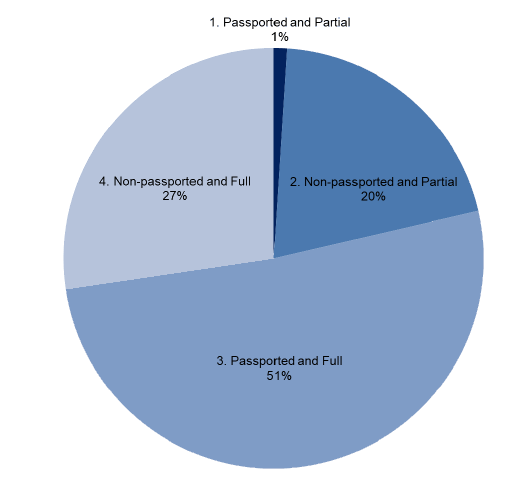
a Figures are rounded to the nearest 10. Components may not sum to total due to rounding.
Contact
Email: eddie.chan@gov.scot
There is a problem
Thanks for your feedback